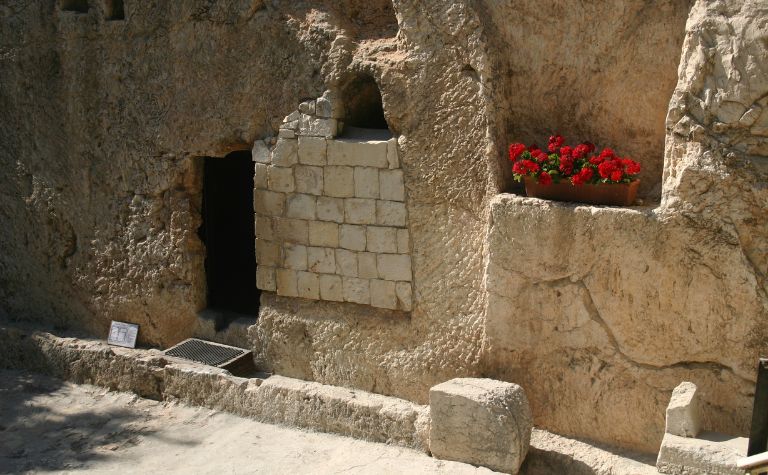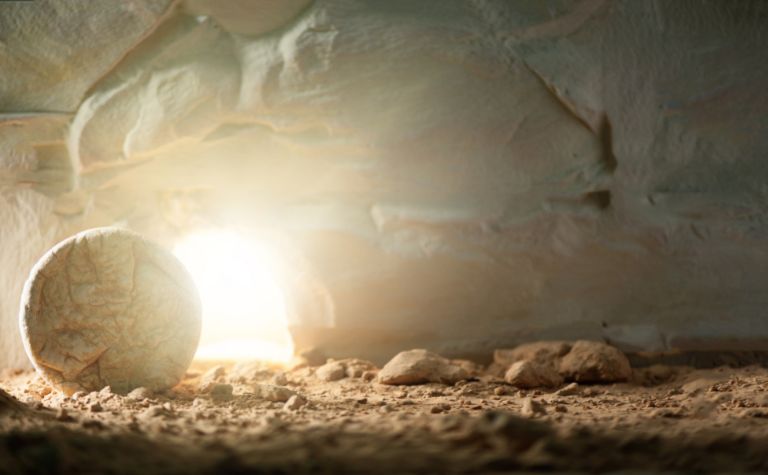Jesus of Nazareth is the central figure of the Christian faith. Born approximately 2,000 years ago in Bethlehem, not far from Jerusalem, Jesus never traveled a great distance, wrote a book, or held political office. And while he only lived about 30 years, he changed the world. Jesus’ legacy leads many people to ask where he is buried, some of whom desire to visit his tomb.
The New Testament proclaims that Jesus Christ was only buried for three days before he physically rose from the dead. While travelers today can visit the traditional burial sites, Jesus’ body isn’t there because he ascended into heaven not long after he rose from the dead.
Where was Jesus’ tomb? How big was it? What was it like inside his tomb? Who was Joseph of Arimethea, and what did he have to do with Jesus’ burial? Can people visit Jesus’ burial place today? What happened after Jesus was laid in the tomb? Can people visit Jesus’ tomb today? Keep reading to learn the answers to these questions and others.

What do the Gospels reveal about Jesus’ burial place?
Even though Jesus wasn’t dead for long, the Gospels include several details about the tomb to help readers understand his death and resurrection. The tomb concludes the crucifixion narrative and begins the story of his resurrection.
Where was Jesus’ tomb? The Gospel of John informs readers that people placed Jesus’s body in a tomb that was in a garden near the place where he was crucified (John 19:41). The tomb was just outside the city walls of Jerusalem (John 19:20). Its location meant that many Jews in town for Passover saw Jesus on the cross and read the inscription that Pontius Pilate affixed above his head (John 19:20).
How big was the tomb? Jesus’ tomb was high quality because it was Joseph of Arimathea’s (more below). Jesus’ body was buried in the ground. Instead, his tomb was freshly cut out of rock, and a massive stone covered the entrance (Matt. 27:60; Luke 23:50-56). People had to bend down to see inside, so its entrance was likely below average height (John 20:5-6). Nevertheless, a person could sit inside it (Mark 16:5).
What was it like inside the tomb? Jesus’ tomb had more room than most because Joseph of Arimathea was wealthy. The inside of the tomb consisted of an antechamber, a small room that leads to a large one. Next to the antechamber, a door or short hallway led to the main chamber. Jesus’ body was wrapped in burial cloths and laid in the tomb’s main chamber (cf. John 20:5-6).
Who was Joseph of Arimethea? The New Testament mentions several men named Joseph. Joseph of Arimethea isn’t Jesus’ earthly father (Luke 2:4) or his biological brother (Luke 3:24, 30). Instead, this man was a wealthy member of the Sanhedrin who had faith in God (Matt. 27:57; Mark 15:43; Luke 23:50). After the crucifixion, Joseph asked Pilate for Jesus’ body and laid it in a tomb that he owned (John 19:38-42).

Can people visit Jesus’ tomb today?
Today, two sites claim to be the rightful place of Jesus’ tomb. Historians and Bible scholars debate which is the correct location. Overviewing the arguments reveals that both have strengths and weaknesses.
The Church of the Holy Sepulchre
One site that some people think is the place of Jesus’ burial is called The Church of the Holy Sepulchre, named for the fourth-century church built at the location. A “sepulchre” is “a small room or monument, cut in rock or built of stone, in which a dead person is laid or buried.”
The main arguments for this location are that tradition identifies it as the right place, there are other tombs in the immediate area, and allegedly someone found a piece of the cross at the site. The main argument against this location is that it resides within the city when the Gospels say Jesus was buried outside it. The response to this is that the location was outside the city during Jesus’ life.
The Garden Tomb
North of Jerusalem is a location known as “The Garden Tomb.” It’s next to one of the possible sites of Jesus’ crucifixion called Gordon’s Calvary. One reason people consider this location to be Jesus’ burial place is because of the problems associated with identifying it as The Church of the Holy Sepulchre. The Garden Tomb location viewpoint arose in the late 1800s, meaning it has less tradition behind it.
The main argument against this location is that the reasons for identifying Gordon’s Calvary as the place of Jesus’ crucifixion are weak. The view is mainly based on seeing a “face” in the rock and identifying it as “the place of the Skull” (e.g., Luke 23:33). Others add that the inside and outside of The Garden Tomb don’t adhere to the biblical descriptions of Jesus’ burial place, but with burial practices centuries earlier.
One scholar writes, “Regarding the evidence, it appears that the traditional location of the Holy Sepulchre is the better option for Jesus’ tomb: its location, dating, and tradition provide more compelling evidence than does the view that the Garden Tomb was the site… together these two locations provide valuable information regarding Christ’s death and burial.” [1]

What happened after Jesus was buried?
Sunday morning, three days after Jesus was crucified (according to the Jewish reckoning of time), Matthew says that an earthquake shook Jerusalem before sunrise. “And behold, there was a great earthquake, for an angel of the Lord descended from heaven and came and rolled back the stone and sat on it” (Matt. 28:2-3, ESV).
Women were the first to arrive at the tomb. Each Gospel tells the story uniquely but with a united message. For instance, Matthew and John emphasize the experience of Mary Magdalene (Matt. 28:1; John 20:1-2), whereas Mark and Luke explain that a group of women (including Mary Magdalene) arrived at the tomb (Mark 16:2-5, Luke 24:1-5).
After the women realized Jesus was alive, they were eager to share the news. Matthew says, “they departed quickly from the tomb with fear and great joy, and ran to tell his disciples” (Matt. 28:8, ESV).
Jesus physically rose from the dead. Numerous people saw him with their eyes. Thomas touched his hands. Peter ate with him. Paul writes that Jesus appeared to 500 people at one time: “Then he appeared to more than five hundred brothers at one time, most of whom are still alive, though some have fallen asleep” (1 Cor. 15:6, ESV).
References:
[1] Holman Illustrated Bible Dictionary. p. 1581-1582.
[2] Unger Bible Dictionary
Recent Posts
Every year, millions around the globe commemorate the birth of Jesus Christ on December 25th, a date synonymous with Christmas and festive celebrations. However, despite its widespread...
The term "Nativity" is often immediately associated with the birth of Jesus Christ and the stories surrounding this event. Yet, the essence of the word encompasses much more than a single...
